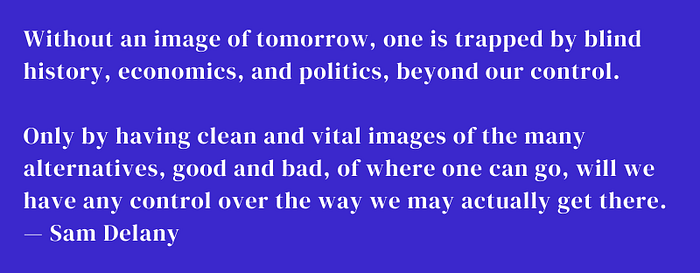#AfroFuturism Edition

Introduction
From Marvel’s “Black Panther” to the critically acclaimed show “Lovecraft Country” and Beyonce’s world-stopping “Black is King” visual album, Afrofuturist stories are having a moment. N.K. Jemisin and Nnedi Okorafor continue to cultivate a growing audience for their speculative work, and emerging African science fiction writers are finally gaining mainstream attention. Comic books were an early site for Afrofuturist work, and Black graphic novelists now find new readership as this cultural interest explodes. However, Afrofuturism is not a new phenomenon, but an established movement dating back to the 1950s, and likely earlier. Its influence on modern visual arts, music, and literature remains undeniable, and given its longevity, it’s no surprise that Afrofuturism spawned some of the most timeless cultural products in the last century.
At its simplest, Afrofuturism is a critical perspective. Intentionally fluid in concept and practice, it has two missions:
- to imagine a political, social, and artistic future void of white supremacist thought and the structures that violently oppress Black communities, and
- to redefine how Black people care for each other outside the confines of the state.
Afrofuturism imagines a world rooted in Black liberation, where Afro-indigenous knowledge systems are uplifted, hierarchies disrupted, and there are no limits to Black potential. Afrofuturism asks more questions than it answers, and that’s the point. It is an exercise in expanding what is possible and questioning what is.
In this edition of the Ujima WIRE, we explore the evolution of Afrofuturism, its aesthetic and political aims, as well as its influence on Ujima’s work.

Black to the Future: Origin Stories
When Alisha Wormsley said “there are Black people in the future,” she also meant there were Black people in the past. Afrofuturism draws on historical Afro-indigenous principles, rooting them in the present, and preserving them for the future. Yoruba spirituality, endemic to southwest Nigeria, emphasizes the existence of multiple worlds through reincarnation, and communication with the metaphysical realm through orishas. The Dogon people of Mali held a deep understanding of astronomy with prolific lore about celestial bodies. Western scientists still doubt the knowledge amassed by the Dogon because they lacked modern-day tools, like telescopes. As Shodona Kettle writes, African cosmology “offers counterstrategies to past and present Western narratives.” Non-linear conceptions of time, belief in other realms, and supernatural beings feature prominently in Afrofuturist works. Afrofuturismpositions these techno-spiritual insights from the past as proof that the Black people of yesterday were advanced, talented, and teeming with foresight.
Afrofuturism, as it’s conceived today, garnered broad attention from a question posed by cultural critic Mark Dery in 1994:
Why do so few African Americans write science fiction, a genre whose close encounters with the Other — the stranger in a strange land — would seem uniquely suited to the concerns of African American novelists?
In “Black to the Future,” he attempts to answer this question through a series of interviews with prominent Black sci-fi writers. In doing so, he wonders:
“Can a community whose past has been deliberately rubbed out, and whose energies have subsequently been consumed by the search for legible traces of its history, imagine possible futures?
It’s worth noting that Mark Dery is a white man, and while he elevated the term, Afrofuturism predates his coining of it. One might say the first Afrofuturists were the enslaved West Africans who braided seeds in their hair- sugarcane, yams, collard greens, and rice — because they believed in future sovereignty on land. The legacy of Black philanthropy and the pooling of resources to fund civil rights was also an Afrofuturist endeavor. As Tricia Rose tells Dery in Black to the Future, “If you’re going to imagine yourself in the future, you have to imagine where you’ve come from; ancestor worship in Black culture is a way of countering historical erasure.” There are traces of Afrofuturism throughout history, and its belief in not just one existence, but many thriving Black futures and alternate realities grants Afrofuturism its staying power.

AfroFuturism: Its Look and Feel
If the artist’s job is to make revolution irresistible, Afrofuturism prefers that revolution to sound infinite, feel abundant, and look both sublime and familiar at once. Under the tent of science fiction, Afrofuturist literature examines notions of displacement, cultural alienation, and the otherness present in Black histories. Among its canon, you’ll find Octavia Butler, Samuel Delany, Nalo Hopkinson, N.K. Jemisin, and Nnedi Okorafor. Mark Sinker, an early Afrofuturist thinker understood the connection between sci-fi and Black futures. He writes, “Black sci-fi acknowledges that the apocalypse already happened, and Black sci-fi writers write about what comes next.” Even W.E.B DuBois experimented with speculative work, penning Comet in 1920, at the height of his career at the NAACP. This lesser-known story about an interracial pair who survive the cosmic fallout of a comet explored whether racial divides could be bridged in a post-apocalyptic world. Spoiler alert: it could not, in fact, be bridged.
Afrofuturist artists feel at home in outer space, because like space, the potentiality of Blackness is infinite. Avant-garde jazz musician Sun Ra’s landmark film and album “Space is the Place,” is perhaps the most obvious example of Afrofuturism’s influence on music. Born of another planet, Sun Ra and his Arkestra traveled through space, propelled by music, discovering new planets for Black folks to inhabit. Before Sun Ra, came Lee “Scratch” Perry, the Jamaican grandfather of dub music, and the first to popularize the “mad scientist” aesthetic. Experimenting with techniques unheard of in the 1960s — echo effects and reverb shots — Perry pioneered the sounds of space. Out of this futuristic, psychedelic lineage came George Clinton of Parliament Funkadelic, Janelle Monae, and Drexciya — a group inspired by the unborn children of enslaved women thrown overboard. Afrofuturist musicians push the limits of sound, genre, and technique, because what good has confinement ever done for Black creators?
Afrofuturist works of visual art are visually ambitious, to say the least. Ellen Gallagher’s paintings have been called “jazz on a canvas,” due to her use of repetitive, distorted, and surreal imagery. Krista Franklin and Jean Michel Basquiat are known for this kind of formal disruption as well, as seen in Molasses and Robot Man. As Joni Boyd Acuff explains, artists in the Afrofuturist tradition “produce disruptions to the present that force a reimagining of the future.” Filmmaker John Akomfrah often weaves together contrasting images in his work, to demonstrate how new forms — sights, sounds, and modes of being — can exist after conflict.

Politics and Practice, Ujima and Beyond:
Afrofuturism is not about escapism, romanticizing the past, or fantasy for fantasy’s sake. Instead, it is deeply engaged in the political work of today, asking: What are we doing today to ensure future liberation? What are the ways in which future emancipation shows up now? What past strategies can we repurpose and expand on?
Afrofuturism invites us to reimagine the systems — across food, labor, housing, and local economies — that don’t serve the interests of people of color. Octavia Butler was not an organizer, but the themes explored in her novels were deeply political and took aim at policing, climate change, and queer liberation.
In an Afrofuturist world, Black people are not marginal characters, but the primary protagonists. One might imagine a world where the over-policing of Black people is replaced by a deep care ethic. A world where community ownership, cooperation, and grassroots democracy are lived realities. A world where social and ecological well-being takes priority over profit and growth at all costs — degrowth is the norm. As Micah Yongo adds, Afrofuturist cultural works “provide a new language to address the increasingly complicated frameworks of discrimination,” — the first step in its upheaval.
To that end, Boston Ujima Project can be considered an exercise in Afrofuturist worldmaking. When it comes to addressing the needs of working-class Black and brown communities of Boston, insightful solutions are not lost in the past, nor deferred to a later date. We are building them today. Our solutions were forged on Afro-indigenous cooperative practices like susu and informal networks of mutual aid, and we believe in collaborative, not competitive, ways of being, as expressed through our fundraising practices for instance. Our ecosystem of investors, artists, activists, partner institutions, and entrepreneurs embraces a non-linear, multi-pronged path to change. Internally, we resist white supremacist ideals like urgency and perfectionism, by prioritizing slow, deliberate work with high standards.
We are a team of industrious dreamers, defying convention to incite visions of the future. Those of you who trusted us enough to come on this journey — as investors, partners and friends — might consider yourselves abetters of Afrofuturism. Most importantly, Afrofuturism pinpoints the mind as the final site of colonization. Once the mind knows freedom, it’s only a matter of time before dreams become a reality.
Paige Curtis is the Culture & Communications Associate at the Boston Ujima Project. Learn more about her work at paigecurtis.me
